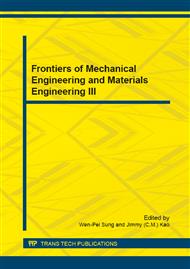p.244
p.248
p.253
p.258
p.262
p.266
p.269
p.273
p.277
Study on the Tensile Properties of Glass Fiber Reinforced Poly Cyclic Butylene Terephthalate Composites under and after High Temperature
Abstract:
A fatal disadvantage of continuously reinforced thermoplastic composites is the high melt viscosity of the matrix which hampers impregnation. However, the melt viscosity of low molecular weight cyclic butylene terephthalate resin can reach extremely low value, which simplifies impregnation and even allows for the use of thermoset production techniques resin transfer moulding. To solve the problem of the glass fiber reinforced poly cyclic butylene terephthalate composites applied in the environment of high temperature, the specimens of composite laminates were tested under and after different temperature. It has been observed that the tensile properties of GF/PCBT composites decrease with increasing temperature between room 25°C and 150°C and tend towards stability after the high temperature.
Info:
Periodical:
Pages:
262-265
Citation:
Online since:
January 2015
Authors:
Price:
Сopyright:
© 2015 Trans Tech Publications Ltd. All Rights Reserved
Share:
Citation:


